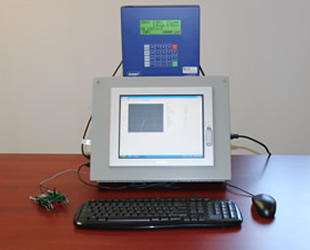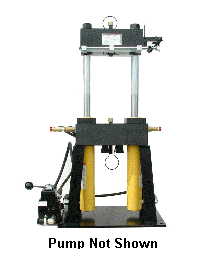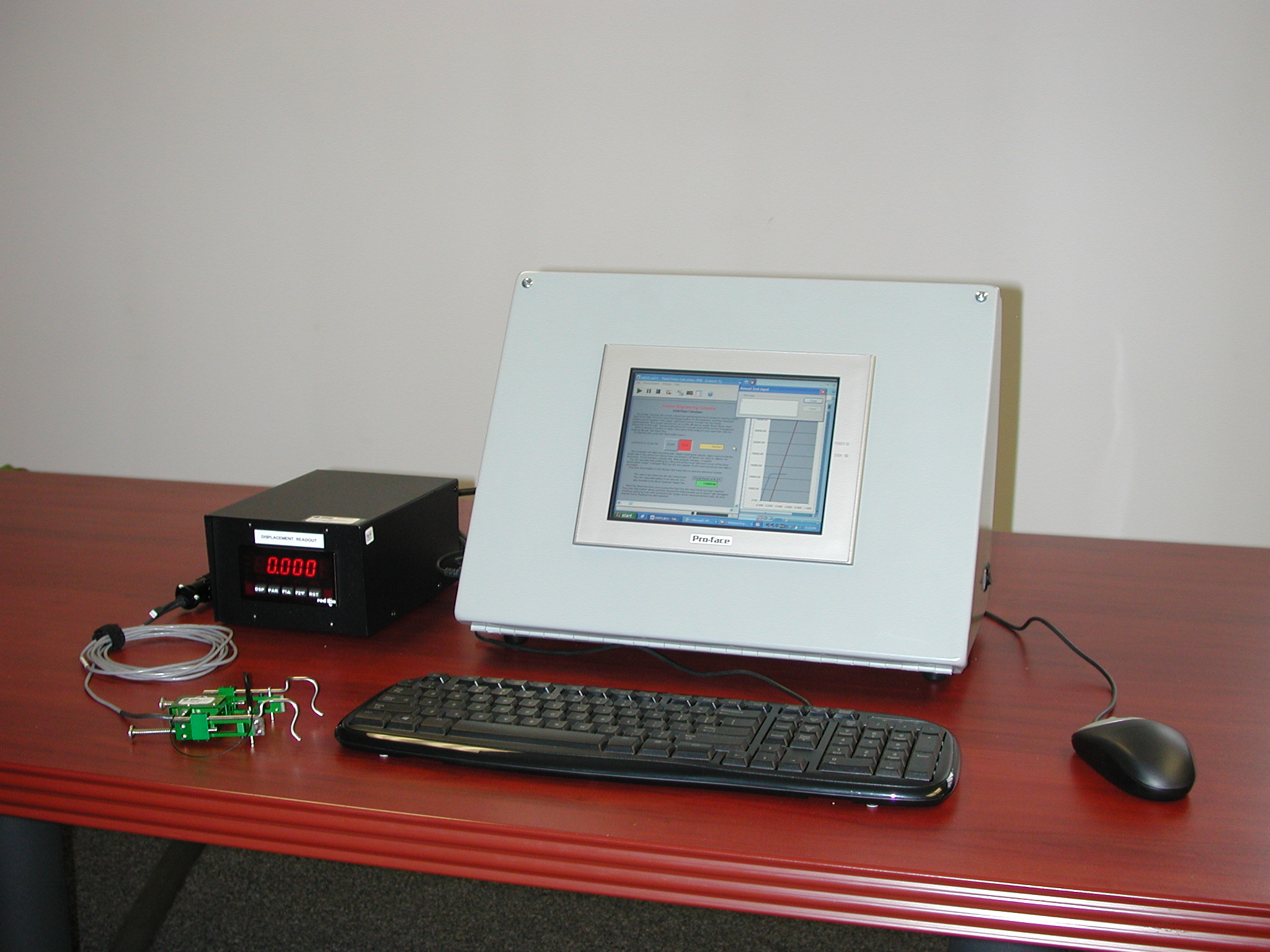Tensile Testers
How much force do you need; 100,000, 40,000, or 5000 Pounds?
Model TT100
Our newest and largest tensile tester. It is intended for testing specimens that will require from 7000 to 100,000 pounds of tensile load to cause fracture. In general, specimens cut from arc-welded test plates are in this range. This model can grip specimens with end dimensions up to 1-1/2 by 2 inches. The reduced section dimensions are a function of the code being followed and the material being tested.
Test plain carbon steel specimens at full thickness up to a maximum of 1.5 inches, as well as others. In ASME Section IX, for example, a reduced section of 3/4 x 1-1/2 inches will allow testing of any material having a maximum tensile strength of 88,800 psi. Materials having higher tensile strengths can be tested by sawing rectangular specimens lengthwise or by using multiple standard round tensile specimens that have smaller areas.

- Meets ASME, AWS Codes
- Meets MIL Standards
- Calibration traceable to NIST
- 100,000 lb. Maximum load +/- 1% Accuracy
- 7,000 lb. Minimum load +/- 1% Accuracy
- Integral hydraulic system
- Flat jaws for up to 1-1/2 x 2 inch section
- Digital readout of live and peak loads
- Auto zero of digital readout
Yield Point Calculator
The TT-YP Yield Point Option allows the Model TT100 to be used for base metal testing. The ASTM Class B1 extensometer (green item to the left of the keyboard) attaches to the specimen. A second Digital Readout (blue item) measures stretching of the specimen (strain). The computer combines force readings from the standard Digital Readout with the strain readings to plot a curve. The computer calculates the force at which the yield point at 0.2% offset occurs (the most common yield point definition). The elongation can also be determined.

TT100 TENSILE TESTERS
A set of four jaws and spacers for testing flat specimens up to 2″ wide and 1-1/4″ thick is standard with each tester.
36″H x 22″W x 20″D (Tester); 21″H x 14″W x
20″D (Pump), 700 lbs.
80″H x 48″W x 30″D, 820 lbs.
ACCESSORIES and OPTIONS
set of
four, 10 lbs
12″H x 18″W x 10″D, plus 5″H x 6″W x 10″D, 36 lbs.
Model TT40
formerly the Model TT1, the TT40 is intended for testing specimens that will require from 4000 to 40,000 pounds of tensile load to cause fracture. In general, specimens cut from arc-welded test plates are in this range. For specimens that will have loads exceeding 40,000 pounds, such as ones from thick plate, the codes and standards allow several alternatives:
- Consider our larger and more powerful Model TT100, above.
- Cut large rectangular specimens lengthwise to create multiple specimens with smaller cross-sectional areas.
- Use standard round tensile specimens that have smaller areas than full-section rectangular specimens. The load required for round tensile bars is well within the limits of the Model TT40.

- Meets ASME, AWS Codes
- Meets MIL Standards
- Calibration traceable to NIST
- 40,000 lb. Maximum load +/- 1% Accuracy
- 4,000 lb. Minimum load +/- 1% Accuracy
- Integral hydraulic system
- Flat jaws for up to 2 x 1-1/4 inch section
- Digital readout of live and peak loads (photo to right)
- Auto zero of digital readout
Yield Point Calculator
The TT-YP Yield Point Option allows the Model TT40 to be used for base metal testing. The ASTM Class B1 extensometer (green item) attaches to the specimen. A second Digital Readout, similar to the one shown above, measures stretching of the specimen (strain). The computer combines force readings from the standard Digital Readout with the strain readings to plot a curve. The computer calculates the force at which the yield point at 0.2% offset occurs (the most common yield point definition). The elongation can also be determined.

TT40 TENSILE TESTERS
A set of four jaws and spacers for testing flat specimens up to 2″ wide and 1-1/4″ thick is standard with each tester.
28″H x 22″W x 20″D (Tester); 21″H x 14″W x
20″D (Pump), 470 lbs.
72″H x 48″W x 30″D, 590 lbs.
ACCESSORIES and OPTIONS
set of four, 10 lbs
12″H x 18″W x 10″D, plus 5″H x 6″W x 10″D, 36 lbs.
Model TT5
formerly the Model TT2, this tester is intended for testing specimens up to 0.15 inches thick that will require from 300 to 5000 pounds of tensile load to cause fracture. In general, resistance-welded specimens are in this range. Also, specimens from arc-welded sheet metal can fall into this range. For specimens that will have loads exceeding 5000 pounds, the Model TT40 or Model TT100 is the correct choice. The model TT5 is also recommended for schools that are interested in teaching the concept of tensile testing. It is easily portable and moderately priced.

- Meets ASME, AWS Codes
- Meets MIL Standards
- Calibration (ASTM E4) traceable to NIST Standards (Digital Readout Version)
- 5000 lb. Maximum load +/- 1% Accuracy (Digital Readout Version)
- 300 lb. Minimum load +/- 1% Accuracy (Digital Readout Version)
- Integral hydraulic system
- Grips specimens up to 0.15 x 1.13 inch section
- Digital readout of live and peak loads
- Auto zero of digital readout
- The Digital Gauge Version has similar functions, but is accurate to +/- 3%
Options
Pumps
Hand
The basic unit uses a hand-operated pump. For most applications this is the best option. The operator has precise control over the entire operation.
Air
The -AO option allows for faster operation, such as when many samples need to be tested. The customer must provide a regulator/filter/lubricator on the air source to be used. The -DRO option is discouraged with this pump.
Electric
The -E option allows for fast operation where air is not available. This pump is not compatible with the -DRO option. Operation is somewhat more complicated because two valves are used, instead of just one, as used on the other options.
Gauges and Readouts
None
The basic unit has no gauge. When doing peel tests only, a gauge is not required.
Digital Gauge
The -DG option gives the ability to determine the load required to break a specimen. The gauge shows the live load during a test. After the specimen breaks, the breaking load can be recalled by the push of a button. Calibration consists of setting the maximum (5000 lb) and minimum (0 lb) loads. Intermediate loads cannot be set. They are characteristic of the TT5 system, but are accurate to better than +/- 3%.
Digital Readout
The -DRO option gives the most accurate means for determining the breaking load. The electronic measuring system is comprised of a microprocessor-controlled readout and a precision pressure transducer. The system is programmed at our factory, during calibration, to give a linear load reading from 300 to 5000 pounds. During subsequent calibrations the user can adjust the system using an IBM-compatible computer, a calibrated load cell and software we can provide. The accuracy of the system is better than +/- 1%. Digital readout of live and peak loads as well as auto zero are standard functions. This option works best with the hand operated pump.


TT5 TENSILE TESTERS
A set of four jaws and spacers for testing flat specimens up to 2″ wide and 1-1/4″ thick is standard with each tester.
31″H x 7″W x 4″D (Tester) 6″H x 4″W x 14″D (Pump), 34 lbs.
ACCESSORIES and OPTIONS
To order the basic tester with an option or options, add the hyphenated Part Number(s) to the basic tester Part No. (Example: TT5-AO or TT5-DRO) and add the listed price(s) to the basic TT5 tester price. Note that pump options are in place of the hand-operated pump.
6″H x 15″W x 15″D, add 25 lbs.
14″H x 10″W x 10″D, add 22 lbs.
6″H x 2.5″W x 1.75″D, 2 lbs.
6″H x 5″W x 5″D (sensor); 3″H x 6″W x 8″D (meter), 5 lbs.
- All prices are F.O.B. Dayton, Ohio.
- Terms: n/30, with approved credit.
- Prices and Specifications are subject to change without notice.
- 15% Restocking charge for all returned goods (no returns of special order items).
- Most major credit cards accepted.
- The prices listed here are for sales within the US and Canada. Sales to other countries may be higher because of additional costs involved for power modification, international transactions and shipping.
California Residents – Click here for the Proposition 65 Warning
Send mail to[email protected]with questions or comments about these services.
